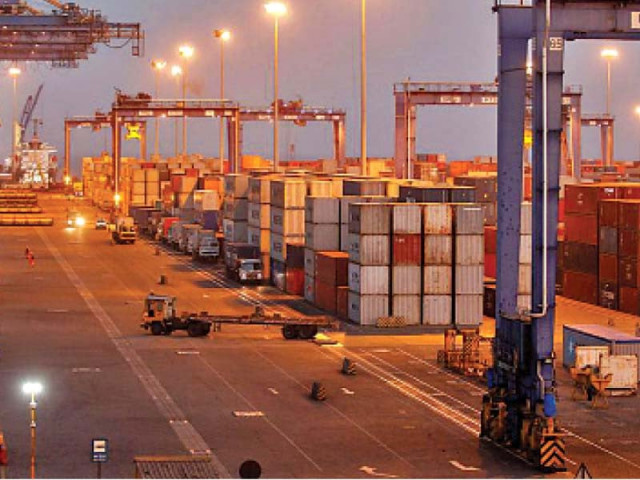Focus on exports vital for growth
It will help reduce pressure on current account deficit, avert balance of payment crisis

Both exports from Pakistan and imports into the country have been on an upward trend relative to the values reported in the first quarter of FY21. According to the statistics published by the Pakistan Bureau of Statistics (PBS), exports in August 2021 were 41% higher than the value in August 2020 and imports were a whopping 95% higher.
However, as the increase in imports outpaced the increase in exports, the trade deficit, at $4.2 billion, was 144% higher than the value reported in August 2020. Cumulatively in the first two months of FY22, the trade deficit touched $7.5 billion, with total imports surpassing $12 billion.
With growth predicted to exceed 5% in this fiscal year accompanied with high dependency on imports, the resultant trade deficit is likely to shatter records this year. It is important to ensure that exports of both goods and services continue to increase so that the pressure on the current account deficit can be alleviated and the vicious cycle involving an ever so ominous balance of payment crisis averted.
In essence, inflows of foreign exchange from various sources, which include exports, foreign direct investment and remittances, need to be sustainable.
Although, PBS provides statistics on the physical goods and commodities that flow through the borders, the State Bank of Pakistan (SBP) provides statistics on the trade-related financial flows involving receipts and payments. The deficit in balance of trade reported by SBP was about $3 billion lower in FY21 than the value reported by PBS. The value of exports reported by PBS and SBP are almost similar in FY21 but the value of imports reported by PBS is approximately $2.6 billion higher than the payments made on imports reported by SBP.
Although, the difference in the trade balance reported by the two sources may not necessarily matter much in the grander scheme, it may be a result of statistical differences in accounting for the transactions as SBP calculates import payments using FOB basis and PBS calculates using CIF basis. Further, favourable payment terms can lower import payments in the shorter run.
Exports reported by PBS in FY21 were approximately $4 billion more than the exports in FY20, with approximately $2.9 billion increase reported in the exports of textile group. The biggest winner within this group was knitwear, reporting more than $1 billion in exports, followed by bedwear and readymade garments.
Exports of raw cotton have declined to negligible values, while the increase in the exports of cotton yarn and cotton cloth have been negligible compared to that of downstream within the textile industry. The textile industry was the recipient of several incentives that include tax- based export schemes, cash subsidies and lower utility costs that have often driven the level of production but also created a vicious cycle as exporters have become increasingly dependent upon them. It is imperative that the government focuses on improving the capabilities of exporters by improving market access and availability of important inputs and increasing the level of competition and innovation within the industry.
Imports of machinery group increased 15% in FY21, with imports of textile machinery reporting a growth of 35%. Similarly, imports of raw cotton and synthetic fibre also increased in FY21 at 68% and 47%, respectively. Although, domestic production of cotton has dropped from 11.9 million tonnes to seven million tonnes since FY17-18, the quantity imported of raw cotton and synthetic fibre have increased by 50%. There is clearly a shift in preference for imported raw materials and intermediate goods in the textile industry. There can be several implications for the decrease in domestic production of cotton that can have adverse impact on the agricultural sector. The increase in imported inputs provides an opportunity for textile producers to source its inputs from otherwise cheaper but higher quality alternatives.
Consumers may demand a certain product mix that is only possible with the availability of imported inputs. In essence, it is essential that producers are able to obtain the most optimal mix of inputs in order to increase their level of competitiveness in the export markets.
Another item that has reported a sharp increase in imports in FY21 is the transport group. Imports of CKD and SKD units increased by $850 million, which is 118% the value reported in FY20. The biggest driver of this increase was the CKD and SKD units of motor cars. Consequently, there has been a significant increase in production of locally assembled cars in Pakistan.
The Economic Advisory Group of Policy Research Institute of Market Economy (PRIME) has recently recommended a review of current policies that promote low value addition, which neither involves the transfer of technology into Pakistan nor involves spillover effects that can contribute and drive economic growth across different industries. The value addition gained from assembly processes is likely to be low, while FDI in similar activities is focused on repatriation of profits extracted from market-seeking activities. The incentives include subsidies and import tariffs on competing goods that not only limits competition in the domestic market but inhibits growth by curtailing innovation and constant churning of new products.
A recent set of tweets by the author reminds the readers that free trade agreements can play an important role to boost trade, particularly if they are designed to increase the participation in global and regional value chains.It is imperative for Pakistani policymakers to focus on export growth rather than on curtailing imports to avert a balance of payment crisis, particularly if the major objective is to increase economic growth rates as the next election approaches.
The writer is the Assistant Professor of Economics & Research Fellow at CBER IBA
Published in The Express Tribune, September 13th, 2021.
Like Business on Facebook, follow @TribuneBiz on Twitter to stay informed and join in the conversation.



















COMMENTS
Comments are moderated and generally will be posted if they are on-topic and not abusive.
For more information, please see our Comments FAQ